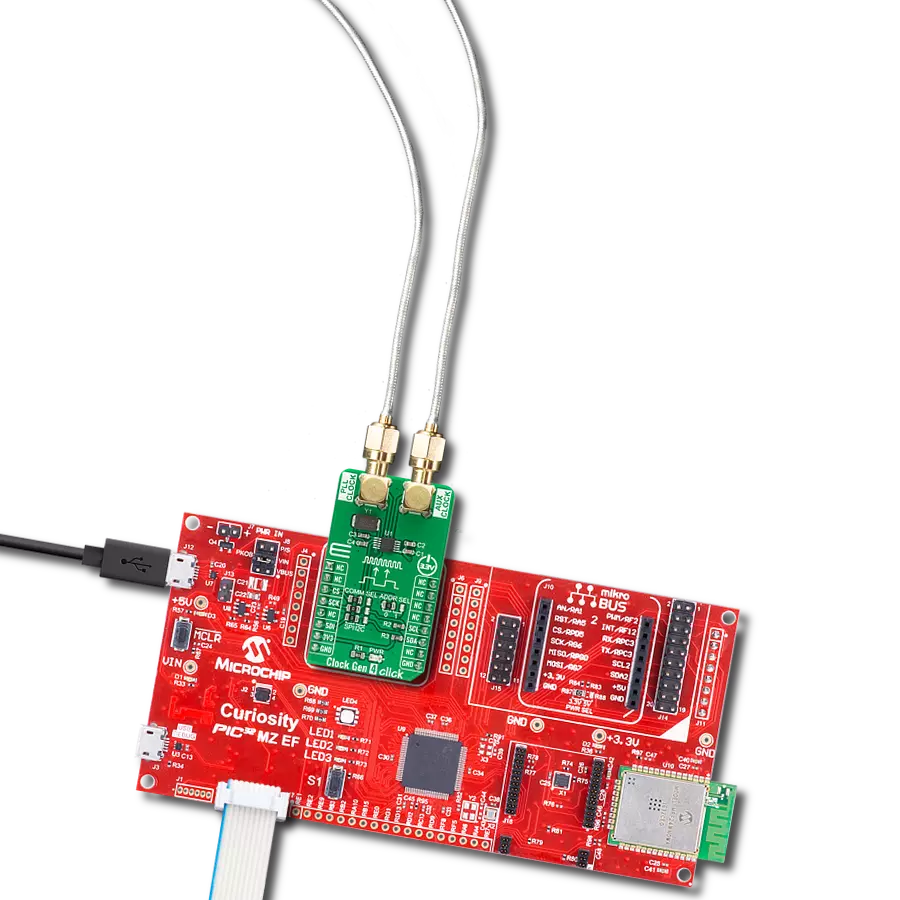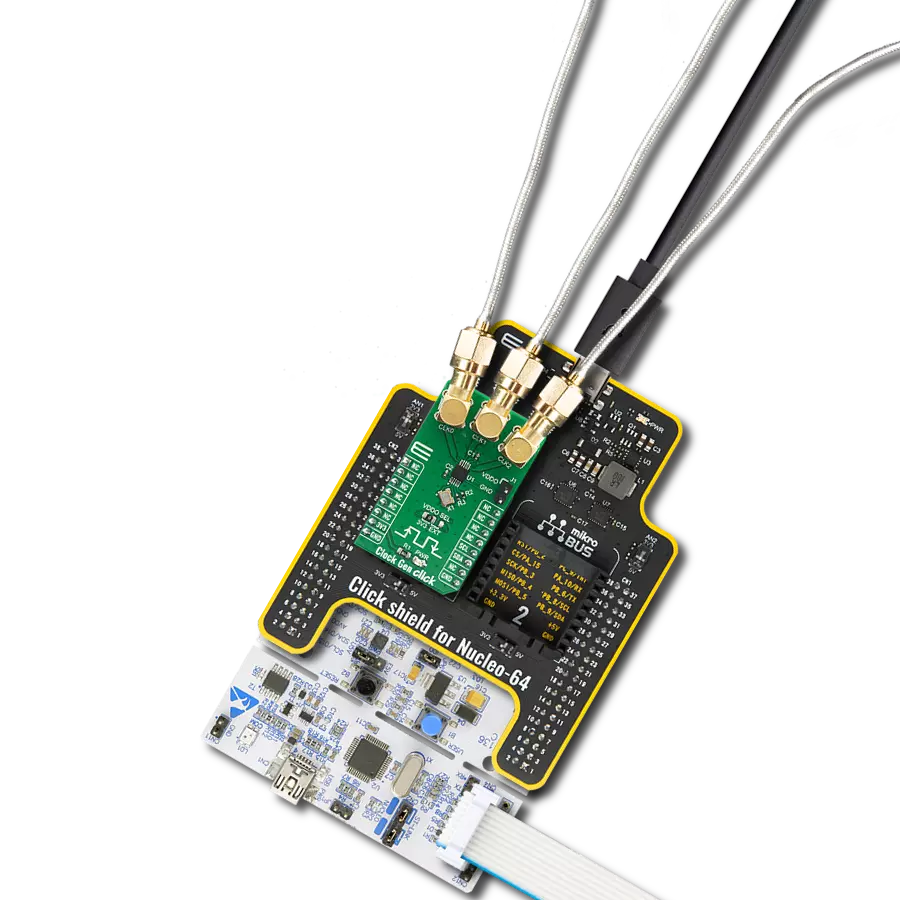Design and develop a waveform generator that produces specific waveforms to simulate sensor inputs for testing and validation purposes
A
A
Hardware Overview
How does it work?
Waveform 3 Click is based on the AD9837, a fully integrated direct digital synthesis (DDS) device capable of producing high-performance sine and triangular wave outputs from Analog Devices. It also has an internal comparator that allows the creation of a square wave for clock generation. With 28-bit wide frequency registers, the output frequency and phase are software-programmable, allowing easy tuning. The AD9837 is capable of a broad range of complex and straightforward modulation schemes fully implemented in the digital domain, allowing the accurate and precise realization of complex modulation algorithms using DSP techniques. The internal circuitry of the AD9837 consists of a numerically controlled oscillator (NCO), frequency and phase modulators, SIN
ROM, a DAC, a comparator, and a regulator. Also, it has a high-performance, onboard 16MHz trimmed general oscillator that can serve as the master clock for the AD9837 achieving a resolution of 0.06Hz. The AD9837 offers a variety of outputs available from an onboard output SMA connector. The various output options (sine, triangular, and square wave) from the AD9837 make this Click board™ suitable for various applications, including modulation applications. It is also ideal for signal generator applications, and with its low current consumption, it is also suitable for applications in which it can serve as a local oscillator. The Waveform 3 Click communicates with MCU using the 3-Wire SPI serial interface compatible with standard SPI, QSPI™, MICROWIRE™, and DSP interface
standards and operates at clock rates up to 40MHz. Besides, it possesses additional functionality, such as a programmable Sleep function that allows external control of the Power-Down mode and Reset function, which resets the appropriate internal registers to 0 to provide an analog output of mid-scale. Remembering that the reset function does not reset the phase, frequency, or control registers is essential. This Click board™ can only be operated with a 3.3V logic voltage level. The board must perform appropriate logic voltage level conversion before using MCUs with different logic levels. However, the Click board™ comes equipped with a library containing functions and an example code that can be used as a reference for further development.
Features overview
Development board
PIC18F57Q43 Curiosity Nano evaluation kit is a cutting-edge hardware platform designed to evaluate microcontrollers within the PIC18-Q43 family. Central to its design is the inclusion of the powerful PIC18F57Q43 microcontroller (MCU), offering advanced functionalities and robust performance. Key features of this evaluation kit include a yellow user LED and a responsive
mechanical user switch, providing seamless interaction and testing. The provision for a 32.768kHz crystal footprint ensures precision timing capabilities. With an onboard debugger boasting a green power and status LED, programming and debugging become intuitive and efficient. Further enhancing its utility is the Virtual serial port (CDC) and a debug GPIO channel (DGI
GPIO), offering extensive connectivity options. Powered via USB, this kit boasts an adjustable target voltage feature facilitated by the MIC5353 LDO regulator, ensuring stable operation with an output voltage ranging from 1.8V to 5.1V, with a maximum output current of 500mA, subject to ambient temperature and voltage constraints.
Microcontroller Overview
MCU Card / MCU

Architecture
PIC
MCU Memory (KB)
128
Silicon Vendor
Microchip
Pin count
48
RAM (Bytes)
8196
You complete me!
Accessories
Curiosity Nano Base for Click boards is a versatile hardware extension platform created to streamline the integration between Curiosity Nano kits and extension boards, tailored explicitly for the mikroBUS™-standardized Click boards and Xplained Pro extension boards. This innovative base board (shield) offers seamless connectivity and expansion possibilities, simplifying experimentation and development. Key features include USB power compatibility from the Curiosity Nano kit, alongside an alternative external power input option for enhanced flexibility. The onboard Li-Ion/LiPo charger and management circuit ensure smooth operation for battery-powered applications, simplifying usage and management. Moreover, the base incorporates a fixed 3.3V PSU dedicated to target and mikroBUS™ power rails, alongside a fixed 5.0V boost converter catering to 5V power rails of mikroBUS™ sockets, providing stable power delivery for various connected devices.
Used MCU Pins
mikroBUS™ mapper
Take a closer look
Click board™ Schematic

Step by step
Project assembly
Software Support
Library Description
This library contains API for Waveform 3 Click driver.
Key functions:
waveform3_cfg_setup- Config Object Initialization function.waveform3_init- Initialization function.waveform3_default_cfg- Click Default Configuration function.
Open Source
Code example
The complete application code and a ready-to-use project are available through the NECTO Studio Package Manager for direct installation in the NECTO Studio. The application code can also be found on the MIKROE GitHub account.
/*!
* @file main.c
* @brief Waveform3 Click example
*
* # Description
* This demo app shows the basic capabilities of Waveform 3
* Click board. First, the sinusoidal wave is incremented
* to targeted frequency for visually pleasing introduction
* after which it changes between 4 modes of output.
*
* The demo application is composed of two sections :
*
* ## Application Init
* Application initializes the UART LOG and SPI drivers,
* resets the device and sets frequency and phase shift to
* default values. In the end, the mode is set with the
* preferred freq and phase channel.
*
* ## Application Task
* Task commences with the start frequency rising up to
* the targeted one. When it reaches desired frequency,
* the mode changes every 5 seconds which includes:
* sinusoidal, triangular, DAC divided by 2 and DAC
* outputs respectively.
*
* *note:*
* Waveform 3 Click might not provide a high enough peak to peak signal on higher frequencies.
* The user can freely implement custom buffer for the output stage.
* Special thanks to my esteemed co-worker Nenad Filipovic for support during firmware development.
*
* @author Stefan Nikolic
*
*/
#include "board.h"
#include "log.h"
#include "waveform3.h"
static waveform3_t waveform3;
static log_t logger;
static uint32_t start_frequency = 100;
static uint32_t rising_factor = 10;
static uint32_t target_frequency = 10000;
void application_init ( void ) {
log_cfg_t log_cfg; /**< Logger config object. */
waveform3_cfg_t waveform3_cfg; /**< Click config object. */
/**
* Logger initialization.
* Default baud rate: 115200
* Default log level: LOG_LEVEL_DEBUG
* @note If USB_UART_RX and USB_UART_TX
* are defined as HAL_PIN_NC, you will
* need to define them manually for log to work.
* See @b LOG_MAP_USB_UART macro definition for detailed explanation.
*/
LOG_MAP_USB_UART( log_cfg );
log_init( &logger, &log_cfg );
log_info( &logger, " Application Init " );
// Click initialization.
waveform3_cfg_setup( &waveform3_cfg );
WAVEFORM3_MAP_MIKROBUS( waveform3_cfg, MIKROBUS_1 );
err_t init_flag = waveform3_init( &waveform3, &waveform3_cfg );
if ( init_flag == SPI_MASTER_ERROR ) {
log_error( &logger, " Application Init Error. " );
log_info( &logger, " Please, run program again... " );
for ( ; ; );
}
waveform3_default_cfg( &waveform3 );
Delay_ms ( 500 );
log_info( &logger, " Application Task " );
waveform3_set_mode( &waveform3, WAVEFORM3_CFG_MODE_SINUSOIDAL, WAVEFORM3_CFG_FREQ_REG0, WAVEFORM3_CFG_PHASE_REG0 );
}
void application_task ( void ) {
uint8_t cfg_mode_switch;
if ( start_frequency < target_frequency ) {
if ( start_frequency / rising_factor < 100 ) {
start_frequency += rising_factor;
waveform3_set_freq( &waveform3, start_frequency, WAVEFORM3_CFG_FREQ_REG0 );
Delay_ms ( 5 );
} else {
rising_factor += 10;
}
} else {
for ( cfg_mode_switch = 0 ; cfg_mode_switch < 4 ; cfg_mode_switch++ ) {
waveform3_set_mode( &waveform3, cfg_mode_switch, WAVEFORM3_CFG_FREQ_REG0, WAVEFORM3_CFG_PHASE_REG0 );
Delay_ms ( 1000 );
Delay_ms ( 1000 );
Delay_ms ( 1000 );
Delay_ms ( 1000 );
Delay_ms ( 1000 );
}
}
}
int main ( void )
{
/* Do not remove this line or clock might not be set correctly. */
#ifdef PREINIT_SUPPORTED
preinit();
#endif
application_init( );
for ( ; ; )
{
application_task( );
}
return 0;
}
// ------------------------------------------------------------------------ END
Additional Support
Resources
Category:Clock generator





































